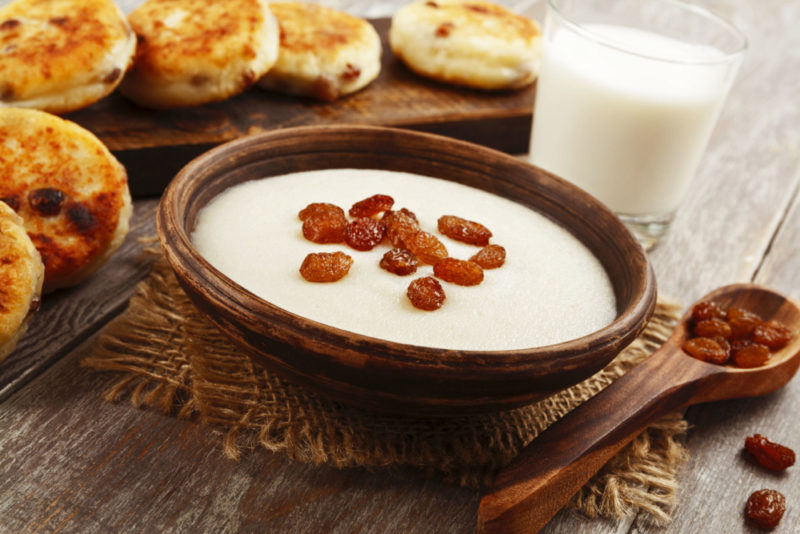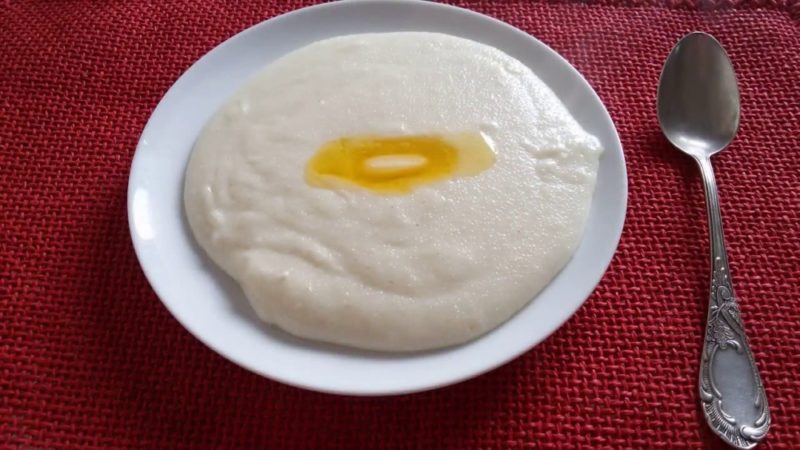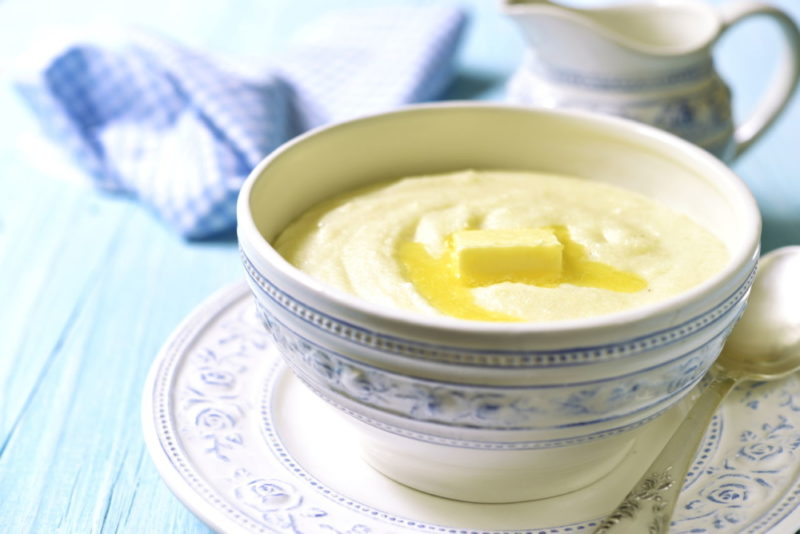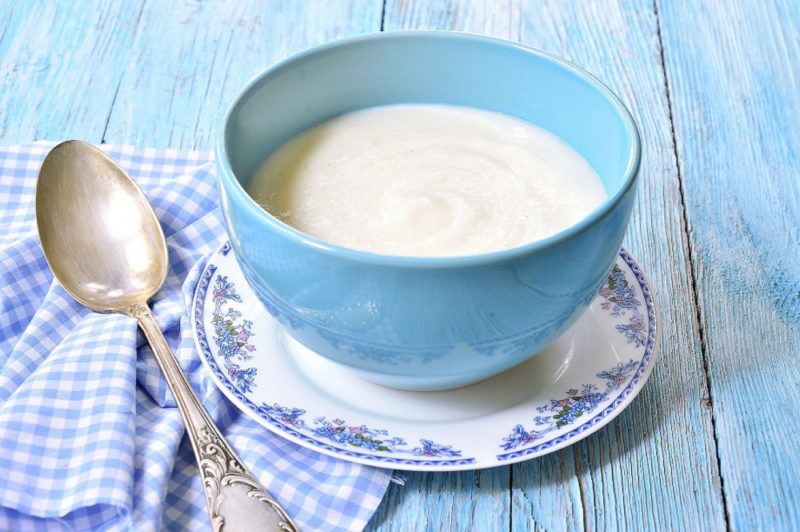This food, familiar from childhood, has become a favorite for many people for life. However, from the point of view of the benefits of the dish for both adults and children, the opinions of experts are very controversial. It is possible to give an objective assessment of this by answering the question of how many calories are in semolina porridge? Does it benefit children? Is it necessary with a diet?
Material Content:
The chemical composition and energy value of semolina porridge
Recently, they say a lot that it is more harmful than good. Energy value - 328 kcal per 100 grams of dry product.
The cereal contains the following components:
- minerals: zinc 0.59 mg, sulfur 75 mg, chlorine 21 mg, phosphorus 85 mg, magnesium 18 mg, iron 1 mg, calcium 20 mg;
- saturated fatty acids are 0.2 g;
- proteins - 10.3 g;
- fats - 1 g;
- carbohydrates - 70.6 g;
- dietary fiber - 3.6 g;
- di - and monosaccharides - 1.6 g;
- starch - 68.5 g;
- vitamins: groups B, PP, E.
Semolina is small particles of refined wheat grain. There is as much benefit in it as in premium flour, considered a refined product, the use of which slows down the metabolism in the human body and leads to obesity.
Calorie content and BJU
More recently, the beneficial qualities of semolina have not been discussed. She was an obligatory dish in child care facilities. Now pediatricians are against feeding her children under 1 year old for the reason that the phytin contained in the composition inhibits the absorption of vitamin D, iron, and calcium. And gluten contributes to allergic reactions. Therefore, food is contraindicated in cases of celiac disease, diabetes, obesity and pregnant women.
Not every housewife is able to get a delicious semolina porridge so that there are no lumps in it.It is better to fill the cereal in heated, rather than boiling water. Stir with a spoon immediately, without letting the grains settle to the bottom of the pan. Boil for 1-2 minutes. Set the pot aside from the fire, close the bowl and let the dish reach. This cooking method saves most of the nutrients.
The nutritional value of the treat depends on its constituents (the calculation is presented in kilocalories per 100 g of porridge):
- cooked on water - 79;
- in milk - 98;
- milk porridge with butter - 120;
- the same, but with the addition of sugar - 155.
A dish is considered dietary if boiled in water. The presence of a sweet component increases its calorie content. 1 h spoonful of sweet crystals contains 30 kcal, 5 g butter is 40 kcal.
BZHU in 100 g semolina:
- fat 3.2 g - 20%;
- carbohydrates 15.3 g - 60%;
- proteins 3 g - 12%.
The cereal has a low fiber content because the top layer of grain is removed during grinding. The content of such a component is 3.6 g in 100 grams of semolina.
On the water
A dish cooked on water is less caloric than dairy food. It does not irritate the stomach, because 90% consists of starch. Contains 16.5 g of carbohydrates and is recommended for weight loss. Calorie content of semolina porridge cooked on water - 80 kcal per 100 g.
Preparing this food option in the following way:
On 1 tbsp. cereals take 4 tbsp. filtered fluid. Pour grain into heated water, constantly stirring in one direction, forming a sort of cycle. Bring the composition to a boil and cook for 2 minutes. After being removed from the heat and insist under the lid.
In milk
Milk semolina contains amino acids, is more nutritious and beneficial for the digestive tract. It is important to know how many calories in semolina porridge in milk. It turns out that there are not many of them - 98 kcal per 100 grams.
For cooking, take 1 tbsp. cereals and 4 tbsp. whole milk. You can pre-fry semolina in butter for several minutes until a yellowish tint. Sweeten the finished dish with sugar, honey or jam, add cinnamon for the aroma.
Useful properties for the body
Semolina is the only one of all similar components that is absorbed by the lower intestine. During the promotion cleans it of mucus, excess fat, harmful substances. It has a beneficial effect on the body and is recommended for patients with diseases of the gastrointestinal tract: gastritis, pancreatitis. With insufficient weight, it is also useful. The chemical composition indicates that cereal, used in reasonable quantities, benefits the cardiovascular system, brain, and liver.
Substances present in the composition have a beneficial effect:
- phytin - promotes the formation and formation of bones, regulates the exchange of calcium and phosphorus, stimulates hematopoietic function;
- Vitamin E enhances brain activity, restores the nervous system;
- magnesium is involved in the healing of muscle tissue;
- potassium improves kidney and heart function;
- phosphorus increases energy digestibility;
- zinc restores immunity.
Semolina porridge can be a good helper in the fight against excess weight.
The diet on such a product is distinguished by taste, it is nutritious and in addition effective. You can eat porridge three times a day with milk with a fat content not exceeding 2.5%. Do not add butter and sugar. It is permissible to sweeten with jam, honey, dried fruits, undigested condensed milk. Do not include bread or rolls in the diet. This menu is designed for just one week.
You can not go on a semolina diet for diabetes, intolerance to food components, metabolic disorders, until adulthood, during pregnancy and lactation.
Before starting a program, consult a doctor.
Manka is not only eaten, but also used in cosmetology. A scrub can be made from a handful of cereals by combining with vegetable oil or cream.
Masks from it are easy to prepare and very effective. For rejuvenation, use the following recipe:
· Cook 2 tbsp. l semolina in 100 ml of milk;
· Add 2 tbsp. l beer, 1 tbsp. l nettle leaves;
Attach 1 tsp. natural oil.
· Insist 5-7 minutes, then apply the mask for 0.5 hours.
Fishermen have learned to use cereals for fishing. Steep porridge is cooked with a Revit flavor or garlic. Catch for such a "breakfast" is provided.
In culinary, dumplings, pancakes, casseroles, meatballs, soufflés and even pies are prepared from semolina.
Nutritionists and doctors can not determine in any way - it brings benefits or harm. Before you eat it, weigh the pros and cons so as not to harm your own body.

















